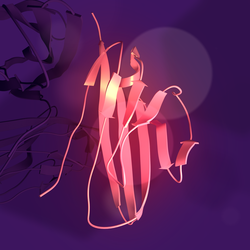Sodium channel subunit beta-3is aproteinthat in humans is encoded by theSCN3Bgene.[5][6]Two alternatively spliced variants, encoding the same protein, have been identified.
Function
editVoltage-gated sodium channels are transmembraneglycoproteincomplexes composed of a large alpha subunit and one or more regulatory beta subunits. They are responsible for the generation and propagation ofaction potentialsin neurons and muscle. This gene encodes one member of the sodium channel beta subunit gene family, and influences the inactivation kinetics of the sodium channel.[6]
Clinical significance
editMutations in the gene are associated with abnormal cardiac electrophysiology.[7][8]
See also
editReferences
edit- ^abcGRCh38: Ensembl release 89: ENSG00000166257–Ensembl,May 2017
- ^abcGRCm38: Ensembl release 89: ENSMUSG00000049281–Ensembl,May 2017
- ^"Human PubMed Reference:".National Center for Biotechnology Information, U.S. National Library of Medicine.
- ^"Mouse PubMed Reference:".National Center for Biotechnology Information, U.S. National Library of Medicine.
- ^Morgan K, Stevens EB, Shah B, Cox PJ, Dixon AK, Lee K, Pinnock RD, Hughes J, Richardson PJ, Mizuguchi K, Jackson AP (Apr 2000)."β3: An additional auxiliary subunit of the voltage-sensitive sodium channel that modulates channel gating with distinct kinetics".Proc Natl Acad Sci U S A.97(5): 2308–13.Bibcode:2000PNAS...97.2308M.doi:10.1073/pnas.030362197.PMC15797.PMID10688874.
- ^ab"Entrez Gene: SCN3B sodium channel, voltage-gated, type III, beta".
- ^Hakim P, Gurung IS, Pedersen TH, Thresher R, Brice N, Lawrence J, Grace AA, Huang CL (2008)."Scn3b knockout mice exhibit abnormal ventricular electrophysiological properties".Prog. Biophys. Mol. Biol.98(2–3): 251–66.doi:10.1016/j.pbiomolbio.2009.01.005.PMC2764399.PMID19351516.
- ^Hakim P, Brice N, Thresher R, Lawrence J, Zhang Y, Jackson AP, Grace AA, Huang CL (January 2010)."Scn3b knockout mice exhibit abnormal sino-atrial and cardiac conduction properties".Acta Physiol (Oxf).198(1): 47–59.doi:10.1111/j.1748-1716.2009.02048.x.PMC3763209.PMID19796257.
Further reading
edit- Hirosawa M, Nagase T, Ishikawa K, et al. (2000)."Characterization of cDNA clones selected by the GeneMark analysis from size-fractionated cDNA libraries from human brain".DNA Res.6(5): 329–36.doi:10.1093/dnares/6.5.329.PMID10574461.
- Hartley JL, Temple GF, Brasch MA (2001)."DNA Cloning Using In Vitro Site-Specific Recombination".Genome Res.10(11): 1788–95.doi:10.1101/gr.143000.PMC310948.PMID11076863.
- Stevens EB, Cox PJ, Shah BS, et al. (2001). "Tissue distribution and functional expression of the human voltage-gated sodium channel beta3 subunit".Pflügers Arch.441(4): 481–8.doi:10.1007/s004240000449.PMID11212211.S2CID25170955.
- Wiemann S, Weil B, Wellenreuther R, et al. (2001)."Toward a Catalog of Human Genes and Proteins: Sequencing and Analysis of 500 Novel Complete Protein Coding Human cDNAs".Genome Res.11(3): 422–35.doi:10.1101/gr.GR1547R.PMC311072.PMID11230166.
- Simpson JC, Wellenreuther R, Poustka A, et al. (2001)."Systematic subcellular localization of novel proteins identified by large-scale cDNA sequencing".EMBO Rep.1(3): 287–92.doi:10.1093/embo-reports/kvd058.PMC1083732.PMID11256614.
- Ratcliffe CF, Westenbroek RE, Curtis R, Catterall WA (2001)."Sodium channel β1 and β3 subunits associate with neurofascin through their extracellular immunoglobulin-like domain".J. Cell Biol.154(2): 427–34.doi:10.1083/jcb.200102086.PMC2150779.PMID11470829.
- Meadows LS, Chen YH, Powell AJ, et al. (2002). "Functional modulation of human brain Nav1.3 sodium channels, expressed in mammalian cells, by auxiliary beta 1, beta 2 and beta 3 subunits".Neuroscience.114(3): 745–53.doi:10.1016/S0306-4522(02)00242-7.PMID12220575.S2CID54320603.
- Strausberg RL, Feingold EA, Grouse LH, et al. (2003)."Generation and initial analysis of more than 15,000 full-length human and mouse cDNA sequences".Proc. Natl. Acad. Sci. U.S.A.99(26): 16899–903.Bibcode:2002PNAS...9916899M.doi:10.1073/pnas.242603899.PMC139241.PMID12477932.
- Ota T, Suzuki Y, Nishikawa T, et al. (2004)."Complete sequencing and characterization of 21,243 full-length human cDNAs".Nat. Genet.36(1): 40–5.doi:10.1038/ng1285.PMID14702039.
- Casula MA, Facer P, Powell AJ, et al. (2004). "Expression of the sodium channel beta3 subunit in injured human sensory neurons".NeuroReport.15(10): 1629–32.doi:10.1097/01.wnr.0000134927.02776.ae.PMID15232296.S2CID26263724.
- Adachi K, Toyota M, Sasaki Y, et al. (2004). "Identification of SCN3B as a novel p53-inducible proapoptotic gene".Oncogene.23(47): 7791–8.doi:10.1038/sj.onc.1208067.PMID15334053.S2CID25309274.
- Suzuki Y, Yamashita R, Shirota M, et al. (2004)."Sequence Comparison of Human and Mouse Genes Reveals a Homologous Block Structure in the Promoter Regions".Genome Res.14(9): 1711–8.doi:10.1101/gr.2435604.PMC515316.PMID15342556.
- Gerhard DS, Wagner L, Feingold EA, et al. (2004)."The Status, Quality, and Expansion of the NIH Full-Length cDNA Project: The Mammalian Gene Collection (MGC)".Genome Res.14(10B): 2121–7.doi:10.1101/gr.2596504.PMC528928.PMID15489334.
- Wiemann S, Arlt D, Huber W, et al. (2004)."From ORFeome to Biology: A Functional Genomics Pipeline".Genome Res.14(10B): 2136–44.doi:10.1101/gr.2576704.PMC528930.PMID15489336.
- Kimura K, Wakamatsu A, Suzuki Y, et al. (2006)."Diversification of transcriptional modulation: Large-scale identification and characterization of putative alternative promoters of human genes".Genome Res.16(1): 55–65.doi:10.1101/gr.4039406.PMC1356129.PMID16344560.
- Mehrle A, Rosenfelder H, Schupp I, et al. (2006)."The LIFEdb database in 2006".Nucleic Acids Res.34(Database issue): D415–8.doi:10.1093/nar/gkj139.PMC1347501.PMID16381901.
- Hakim P, Gurung IS, Pedersen TH, et al. (2008)."Scn3b knockout mice exhibit abnormal ventricular electrophysiological properties".Prog Biophys Mol Biol.98(2–3): 251–66.doi:10.1016/j.pbiomolbio.2009.01.005.PMC2764399.PMID19351516.
External links
edit- GeneReviews/NIH/NCBI/UW entry on Brugada syndrome
- SCNB3+protein,+humanat the U.S. National Library of MedicineMedical Subject Headings(MeSH)
This article incorporates text from theUnited States National Library of Medicine,which is in thepublic domain.






